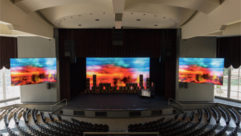
Picture This: Projection Progression
Oct 1, 2007 12:00 PM,
By Jeff Sauer
CEDIA Expo 2007 offers hefty upgrades to already impressive projectors.

Projector upgrades from Epson, JVC, Mitsubishi, Panasonic, Samsung, Sanyo, and Sony were the real story at CEDIA Expo 2007.
My rather flippant answer to, “What have you seen?” and, “What’s hot?” at CEDIA Expo 2007 quickly became, “Thin bezels.” That was a highlight of no fewer than three prominent LCD companies. OK, it’s not that clever, but it sounded more interesting than the real story of CEDIA: some fantastic “upgraded” projectors. 1080p, anamorphic lenses, and price performance sound like last year’s news, but the new models from several manufacturers were hot.
Epson, JVC, Mitsubishi, Panasonic, Samsung, Sanyo, and Sony all announced new 1080p front projectors — many upgrading already highly acclaimed models. First, JVC’s new sub-$8,000 DLA-HD100 (to be sold by JVC’s professional division as the DLA-RS2) will not replace, but augment, the DLA-HD1 (pro version: DLA-RS1) when it ships this November. The newer HD100 will share the form factor of the older HD1, and it will also employ three 0.7in. D-ILA chips. However, the chips and light engine have been modified to double the “native” contrast ratio from the HD1’s 15,000:1 to 30,000:1, still without the use of a dynamic iris. JVC has also increased the processing bandwidth to now produce billions of colors. The HD100 will also feature powered vertical and horizontal lens shift for easier installation, and JVC will have an anamorphic lens option for “native” 2.35:1 viewing.
Sony is also augmenting its current line of SXRD home theater projectors with two new models early this fall: the VPL-VW200 (roughly $15,000) and the VPL-VW60 (roughly $5,000). The new flagship VW200 will feature a new Carl Zeiss Vario-Tesar lens and a Xenon lamp for more accurate colors, as well as an Internet connection or external control. Both the VW200 and VW60 will leverage Sony’s advanced iris technology to achieve a dynamic contrast ratio of 35,000:1, and both will have a 2.35:1 anamorphic lens option.
Sim2 Multimedia had the featured projectors at the Texas Instruments (TI) booth, highlighting the release of TI’s new DarkChip4. The new 3-chip Grand Cinema C3X 1080 increases the native resolution of the original 720p C3X and adds full 10-bit processing; HD scaling and deinterlacing; and very deep installer control over color, gamma, white point, and other image parameters. And never short on style, the Italian company will offer the C3X in black, red, gold, and gunmetal finishes when it ships in November ($29,999). Sim2’s new single-chip DLP model, the Grand Cinema HT3000 HOST (High-definition Optical Signal Transfer), which will be available in October for $19,995, will also have a native 1080p and 10-bit processing, and it will use TI’s Brilliant Color technology and a six-segment (RGBCMY) color wheel for rich images. Yet it’s the new Unishape technology from Sim2 that is most unique. Unishape is a way of modulating the lamp brightness on a frame basis, dimming it on darker screens to expand the color range.
Projectiondesign also showed a 3-chip, high-end DLP projector with 10-bit processing and native 1080p resolution. The explosive Action M80 will be able to generate as much as 8000 lumens and with 10,000:1 contrast, but it will likely be Projectiondesign’s Optical Color Filter Processing, if not the anamorphic lens, that will appeal to those looking for uncompromising image quality.
Samsung’s new SP-A800 is also the first native 1080p projector to come out of Samsung’s partnership with Joe Kane. And while there’s nothing at all flashy about the specifications — a two-generation-old DLP chip, 10,000:1 contrast, 1000 lumens, etc. — Kane has bestowed the A800 with a wealth of image-control features and exceptionally clean electronics to excite even the sternest videophile.
Panasonic also introduced two new LCD-based models: the 1080p PT-AE2000 ($5,999 MSRP and $3,999 MAP) and the 720p PT-AX200 ($2,999 MSRP and $1,999 MAP). The AE2000 improves brightness and contrast, compared to the AE1000, to 1500 lumens and 16,000:1. Almost complete elimination of any visible screen-door effect and an improved dynamic iris. The AX200 is a step up from the AX100, and it now features a unique gaming mode that reduces any processing lag.
Mitsubishi’s HC6000 will replace the current HC5000 (look for great deals on the HC5000 while supplies last), improving iris speed to yield a broader dynamic contrast of 13,000:1. That’s up 30 percent from the HC5000, which already boasted one of the best price/performance values in home theater. The HC6000 will have an MSRP of less than $4,000.
Sanyo and Epson both showed native 1080p LCD-based models featuring — get this — manual horizontal and vertical lens shift. The “UB” in Epson’s second-generation PowerLite Pro Cinema 1080 UB stands for a new UltraBlack technology that claims to achieve contrast ratios as high as 50,000:1. The new D7 chip set uses 12-bit video processing and a new polarized light filter to deliver rich blacks and whites as bright as 1600 lumens. Epson won’t establish formal pricing until closer to the December ship date, but it is expected to be in the similar sub-$4,000 range as the previous Pro Cinema 1080 model. An anamorphic lens option will probably double that price, but specific pricing isn’t yet available.
Intriguingly for installers, Epson, partnering with Atlantic Technology, also showed an integrated screen-speaker-projector system built around the PowerLite Pro Cinema 1080 UB, Ensemble 1080 ($6,999), or its 720p little cousin, Ensemble HD ($4,999). For as easy a home theater install as you can hope for, the center, right, and left speakers are built into the housing for a pull-down screen, while the two surround speakers are built directly into the shelf that the projector sits on. A single console and remote control both audio and video.
With the new PLV-Z2000, Sanyo introduces its first native-1080p home theater projector, but does it at an even more remarkable $2,995.95 price point. A new exclusive Topaz Real HD management color technology that affords as many as 216 billion possible colors, and that’s combined with a native contrast of 15,000 and 1200 lumens of brightness at a very low price.
BEYOND PROJECTION
Naturally, there was a lot more at CEDIA Expo 2007 than just projectors, including next-generation HD DVD (for as little as $299) from Toshiba and new Blu-ray players from a large number of companies, now including Sharp. LG also showed a second generation of the SuperBlu player introduced earlier this year at CES. The main difference is that this new player now carries HD DVD thanks to full support of all HD DVD interactivity.
Almost all of the aforementioned projectors companies also made note of their support for the native 24fps film mode now supported by both HD DVD and Blu-ray. There was also broad adoption of HDMI 1.3, which enables x.y.Color, although very little content yet exists to take advantage of it.
Several flatpanel makers also showed new generation LCD, many with unique features. For example, Samsung’s LN-T4681F not only uses LEDs, rather than florescent lamps, for the backlight, its SmartLighting technology modulates the brightness of the LED across different sectors of individual frames to maximize contrast. This technique was introduced a couple of years ago by Brightside Technologies, but at a significant price premium. Samsung’s 40in., 46in., 52in., and 57in. LCDs (ranging from $2,999 to $7,999) cost only a few hundred dollars more than their CCFL counterparts. Several panels were also promoted as “3D Ready,” touting stereoscopic modes for gaming.
And then there was design. Sharp showed models that were about half the depth of current models. And those thin bezels — Toshiba, Sharp, and Sony all now let you buy a bigger (more expensive) LCD TV for your old cabinet.










